
How to Create a Website Security Audit

In today’s digital age, cybersecurity is more crucial than ever. With cyber threats evolving at an alarming pace, it’s essential to ensure that your website remains secure. One of the best ways to achieve this is through a website security audit. Here’s a comprehensive guide on how to go about it.
What is a Website Security Audit?
A website security audit is a systematic evaluation of your website’s vulnerabilities and threats. It identifies potential weaknesses in your site’s security architecture, allowing you to take corrective measures before a cybercriminal exploits them.
Importance of a Website Security Audit
Protection against cyber threats: A regular audit can identify and rectify vulnerabilities, ensuring your website remains impervious to threats.
Trust and credibility: A secure website guarantees users’ safety, fostering trust and encouraging more interactions.
Regulatory Compliance: With data protection regulations in the U.S.evolving rapidly, complying with these standards demonstrates a commitment to user privacy and protects your business from potential legal ramifications.
How to Create a Website Security Audit
Define the Scope of the Audit
Determine which parts of your website need auditing. This could include your main website, subdomains and any connected databases or applications.
Conduct a Vulnerability Scan
Utilize automated tools to scan your website for common vulnerabilities. These tools can identify issues such as SQL injection, Cross-Site Scripting (XSS), and more.
Manual Penetration Testing
Automated tools can’t catch everything. Hiring a professional or using in-house experts to manually test vulnerabilities is crucial.
Review User Access and Privileges
Ensure only the necessary individuals have access to your website’s backend and databases. Limiting access minimizes the risk of internal threats.
Analyze Content Management System (CMS)
Ensure your CMS is up-to-date and free from vulnerabilities. This includes plugins, themes, and other add-ons.
Check SSL Certificates
Ensure that your SSL certificates are valid and renewed. A secure SSL connection guarantees data integrity between the user’s browser and your server.
Review Website Code
Custom code can introduce vulnerabilities. Regularly review and update your site’s code, ensuring it’s free from potential exploits.
After the Website Security Audit
After the audit is complete, a critical phase begins. Start by analyzing the results, listing out the identified vulnerabilities, and prioritizing them based on potential impact and exploitability. From this analysis, craft a detailed action plan, outlining how and when you’ll address each vulnerability. This plan might involve deploying patches, performing updates, or in some cases, a complete overhaul of certain components.
Once your plan is ready, it’s time to implement the changes. Depending on the scale of modifications, you might require scheduled downtimes, or changes can be rolled out in stages.
Lastly, remember that cybersecurity is an ongoing process. A one-time audit isn’t enough. Set up continuous monitoring tools to get alerts for any potential threats and conduct periodic audits to stay ahead of cybercriminals.
Why Choose JLB?
At JLB, we’re dedicated to ensuring that your website is fortified against potential threats. With a wealth of experience and cutting-edge technology at our disposal, your website’s safety is our top priority. Stay vigilant, stay secure! Contact us today.
Have A Project For Us?
Website design services & digital marketing tailored for user experience and
attracting the right traffic for you with support-that-matters!



